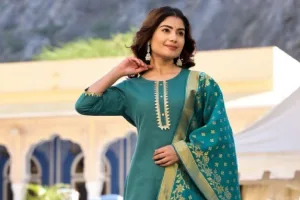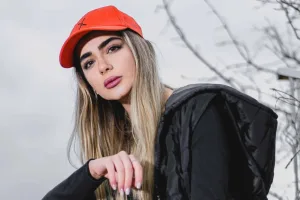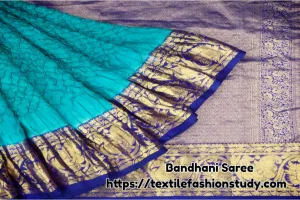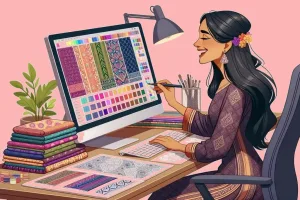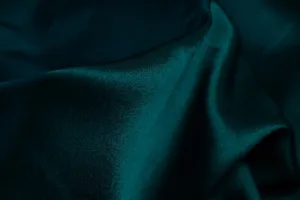Table of Contents
What is Brocade Fabric?
Brocade fabric is respected as a sort of luxuriously fancy fabric with raised themes that are, as often as possible, perplexing designs woven into the cloth. Brocade is a profoundly sought-after fabric that is famous for its fine weaving strategy, extravagant surface, and unmatched strength. It can turn any article of clothing into an extravagant magnum opus. A consideration of brocade fabric analyzes the imagination included in its generation as well as the fabric itself. There is a wealthy history of numerous societies covered up beneath this unmistakably designed weaved cloth.
The term “brocade fabric” too portrays a designed, fancy fabric that is completely built of gold and silver strings. Brocade is a material with a weaved design. Brocade is special among materials since of its complicated plans and smooth strings. Each kind, whether made of silk, cotton, or a more later manufactured combination, includes something uncommon to the table and combines history with a touch of display.
Brocade fabric is more than just lovely; it speaks to the past and shows design and plan, illustrating the kind of deft creativity that has been practiced for ages. A woven cloth called brocade is embellished with a colorful theme that is included amid the weaving preparation. On the other hand, amid the weaving preparation, the weft strings make the designs in the brocade cloth. In expansion, brocade is a silk weave delivered on a linger. Here, more weft strings are required to make a flawlessly brightened design. Weaves with weaving and ornamentation will take off an impact.
Brocade Fabric Properties
Brocade fabric is an ensemble of surfaces and conventions. When you coast your fingers over the surface of brocade fabric, you’re not touching a fabric. You’re following the forms of centuries-old conventions that have woven together strings of history, craftsmanship, and culture. Brocade, a trademark of extravagance and tastefulness, stands out in the material world not just for its appearance but for the wealthy stories it tells and its multi-dimensional tactility. Brocade fabric has diverse, unmistakable characteristics. The following are the properties of this fabric:
- Rich feel: Since brocade fabric contains hoisted themes, it more often than not has an rich feel.
- Detailed Designs: Brocade is eminent for its point by point designs, which as often as possible incorporate geometric shapes, blooms, and vines as motifs.
- Sturdy: Since brocade cloth is thickly woven, it is regularly tough and long-lasting.
- Opulent see: Brocade fabric has a rich see suitable for formal clothing and domestic décor, much appreciated for its elaborate themes and dynamic colors.
- Variety of Materials: Silk, cotton, polyester, and metallic strings are fair a few of the materials that may be utilized to make brocade.
- Thick by Nature: Since brocade fabric is thick, pressing it will not cause it to keep up a tall temperature.
- Wrinkle-resistant: The brocade may have its wrinkles evacuated by giving it a tender wash with a light shampoo.
- Dry washing as it were: The brocade fabric must be dry cleaned in arrange to be cleaned.
- Smooth and Glossy: Brocade fabric is fabulous for evening clothing. Given that the cloth is actually gleaming and silky,.
- Fabric Toughness: There is a part of fabric durability.
- Breathability of Fabric: It is not exceptionally breathable.
- Low Stretchability of Fabric
- Heat Maintenance Capabilities: It can hold warm for a direct sum of time.
Exploring the glorious history of Brocade Fabric
Brocade created from the craftsmanship of weaving gold and silver strings into silk to accomplish riches in the Byzantine Realm. As this sumptuous fabric traveled the Silk Street, it did not take long to gotten to be woven into the fabric of numerous diverse societies. Since of its wonderful excellence, it rapidly got to be a image of wealth and distinction.
Brocade is unmistakable since of its perplexing weaving strategy. Not at all like other materials, where the design is printed on the surface, brocade highlights plans that are woven right into the fabric with the utilize of an extra weft handle. As a result, a fragile decorated impression is delivered that is stylishly appealing and material. The designs, which are habitually geometric plans, creatures, or plants, look
A major calculate in the lavishness of brocade is the materials utilized. Whereas brocade was customarily woven from silk, modern adaptations are made from a assortment of materials, counting rayon and polyester. Be that as it may, the ordinary extravagant sparkle of brocade is determined from metallic strings, such as gold, silver, and other colors that take after their glow.
The story of brocade is encourage upgraded by its social significance. In China, Suzhou—famous for its Suzhou weaving, where the cloth is alluded to as “Jin”—is closely related with brocade. It is fundamental to conventional clothing, festoones ceremonial articles of clothing, and indeed decorates add as a image of good fortune and riches. Over the globe, in Renaissance Europe, it decorated the closets of the privileged, meaning control and prestige.
Brocade has ended up more prevalent in later times, as it is appeared on runways and gives present day clothing a textural component. It looks well with coats, skirts, and adornments, where its lavishness and profundity truly come through. The charm of brocade is not constrained to its tasteful request; it moreover dwells in its capacity to make associations over dissimilar domains, such as those between the obvious and the material, the incredible and the commonplace. The reality that it proceeds to be engaging appears how much individuals need for significant beauty—a fabric that does more for us than fair keep us warm—that joins us to the differing weave of human civilization.
Basically, brocade is interesting as a fabric but moreover as an tribute to human imaginativeness and social bequest. It is a immortal case of the ability of material creation due to its complex weaving strategy, wealthy materiality, and significant social importance.
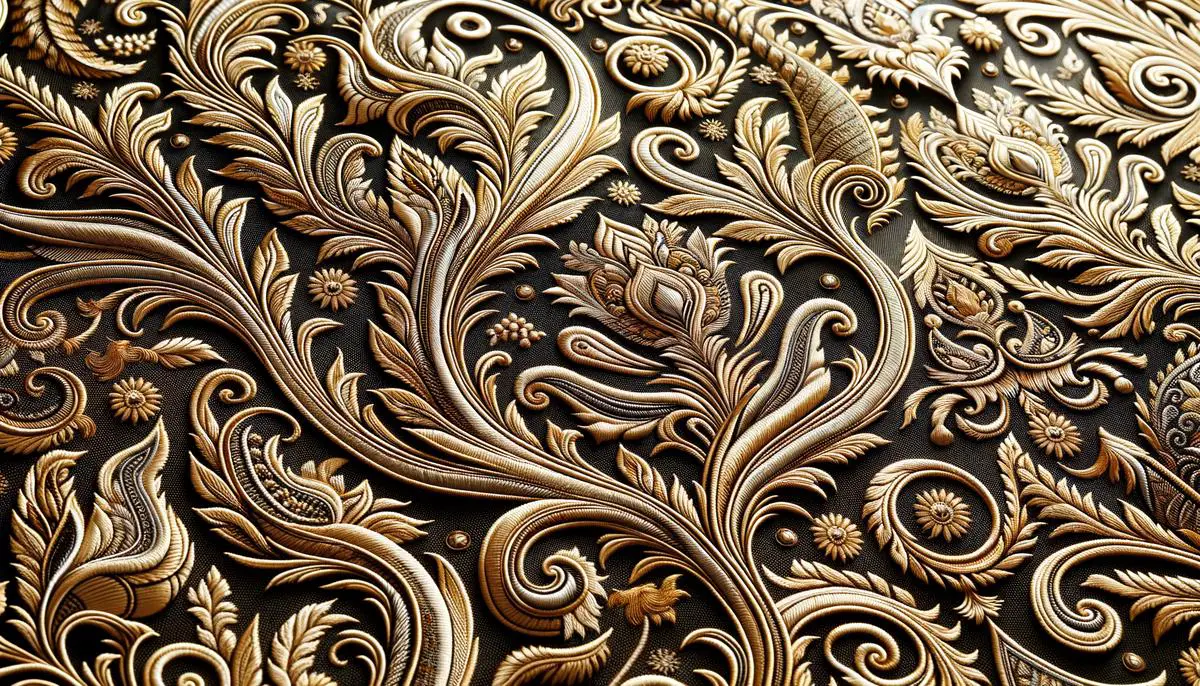
Types of Brocade Fabric
Brocade fabric is made not as it were of silk but too of other yarn sorts. The taking after are the distinctive sorts of brocade fabrics:
- Silk Brocade: Made from silk strings, silk brocade is considered the most sumptuous and is regularly utilized for formal clothing and upholstery. Common characteristics of silk brocade are its extravagance, smoothness, and durability.
- Cotton Brocade: Cotton brocade is more casual and less costly compared to silk brocade. Moreover, this features make the cotton brocade reasonable for domestic furnishings as well as regular clothing.
- Metallic Brocade: This brocade is formed by consolidating metallic strings such as gold or silver. This gives a sparkling impact. This type of fabric is regularly use in ceremonial and formal pieces of clothing. Another name of this fabric is Zari Brocade.
- Synthetic Brocade: Engineered brocade is not as costly as silk and brocade. The manufactured one is cheap to create. Too, the brocade fabric is not comfortable to wear.
- Continuous Brocade: To make the plans, the extra weft gets hung on the fabric back.
- Discontinuous Brocade: The additional weft is woven in nature. It is woven in designed areas.
- Himro Brocade: Himro is an Indian-manufactured fabric made of silk and cotton. The Himro brocade is milder, breathable, stretcher-like cotton. They are tough as well.
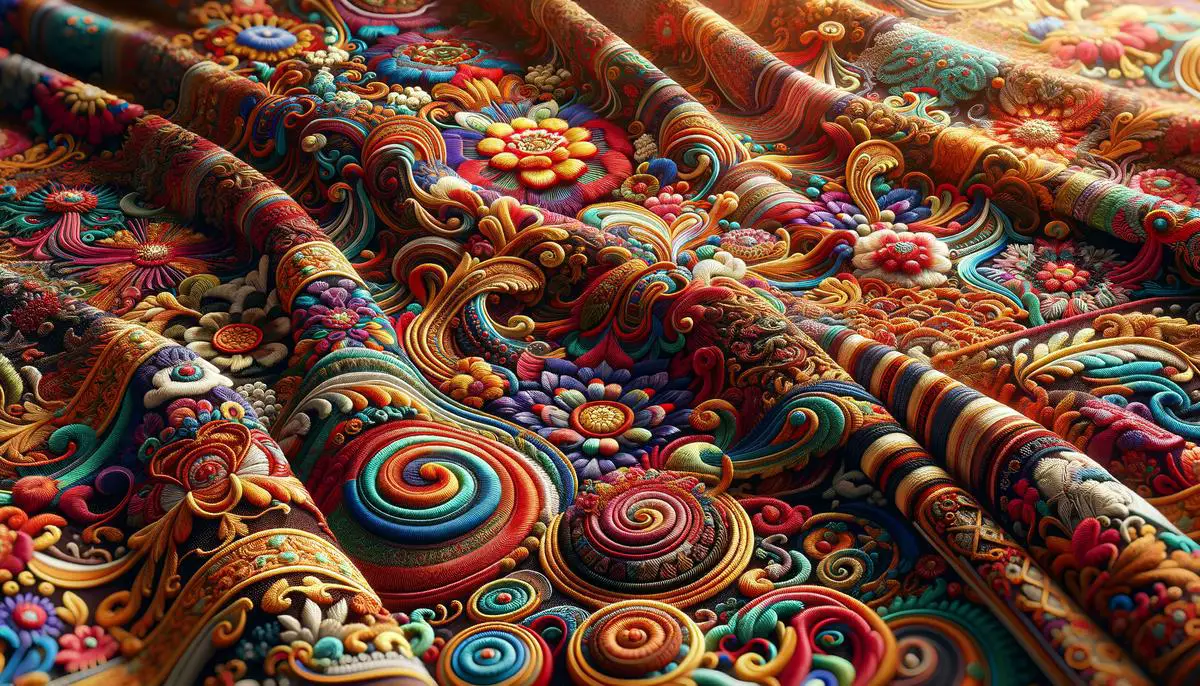
Brocade Fabric Applications
Brocade fabric has diverse applications in our every day lives. The followings are the major applications of brocade:
- Clothes: Brocade fabric is as often as possible utilized to make conventional dress like kimonos and saris as well as formal wear like evening outfits, dresses, and jackets.
- Interior Plan: Brocade is moreover a well known fabric for tablecloths, window ornaments, upholstery, and pillowcases.
- Ceremonial dress: Since brocade fabric is so lavish and typical, it is as often as possible utilized in ceremonial and devout dress worldwide.
- Furnishings: Decorative chairs, lounge chairs with brocade plans, and cushions.
- Vestments: The devout utilize of brocade. Christian subjects are portrayed on brocade cloth. Furthermore, ceremonial dress are made from it.
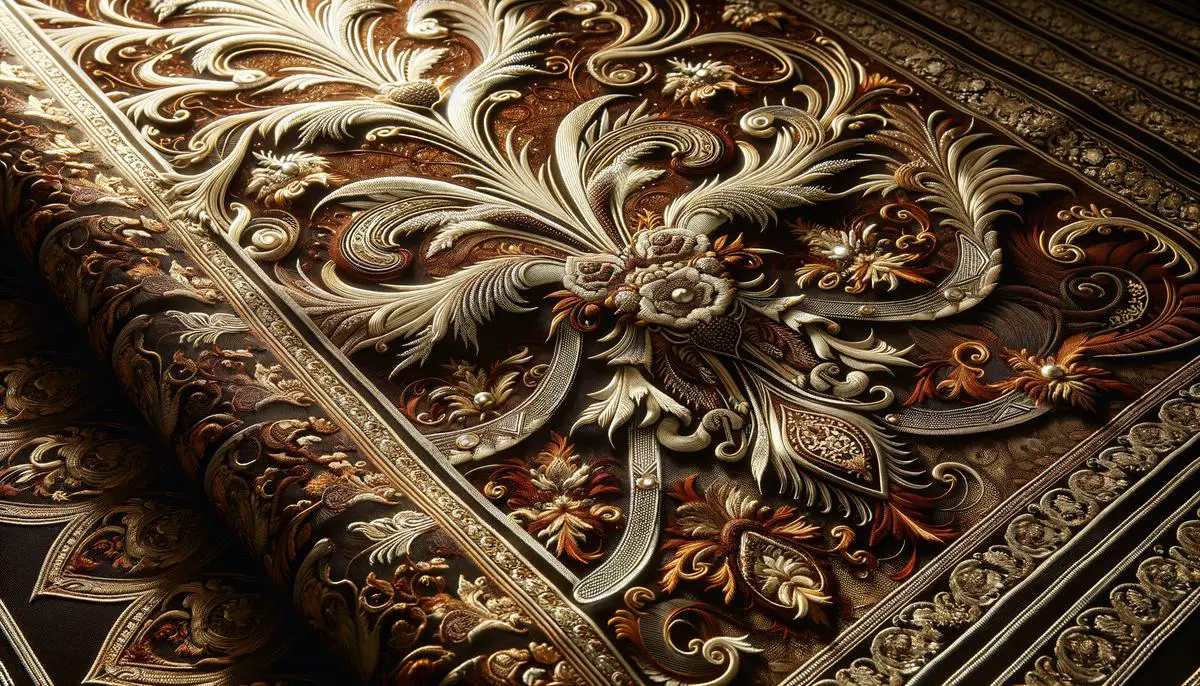
Benefits of Brocade Fabric
The utilize of brocade fabrics for its benefits. The taking after are the points of interest of this fabric:
- Luxurious Tasteful: Brocade cloth gives each furnish a advanced, extravagant look.
- Versatility: There are numerous employments for it, counting insides plan and formal attire.
- Durability: Brocade fabric holds its surface and color indeed after rehashed wear, making it fantastically resilient.
- Cultural esteem: Brocade fabric is a well known alternative for conventional dress and ceremonies since it has verifiable and social esteem in numerous countries.
- Environmentally inviting: The fabricating of silk doesn’t require the utilize of pesticides or fertilizers, making it an naturally inviting process.
- Simple sewing: It’s not difficult to sew.
- Fashionable: In addition, it is reasonable for each gender.
- Wide Run of Alternatives: With distinctive materials, designs, and colors accessible, brocade fabric offers a wide extend of choices to suit distinctive tastes and preferences.
Disadvantages of Brocade Fabric
There are several confinements of this fabric. They are-
- Cost: Fine brocade textures are expensive, especially if they are silk-based or have expound motifs.
- Maintenance: A few brocade fabrics may require additional consideration whereas washing and keeping up them to keep up their surface and outlooks.
- Stiffness: Compared to other materials, certain brocade materials may be more inflexible and less adaptable, which might be awkward, especially when utilized as clothes.
- Restricted Extend: Compared to extend materials, brocade cloth as a rule has less flexibility, which can have an affect on how comfortably and well an thing fits.
- Not Reasonable for Ordinary Wear: Since of its rich see and surface, brocade fabric may not be fitting for day by day utilization, indeed if it loans a touch of class to formal clothing and extraordinary events.
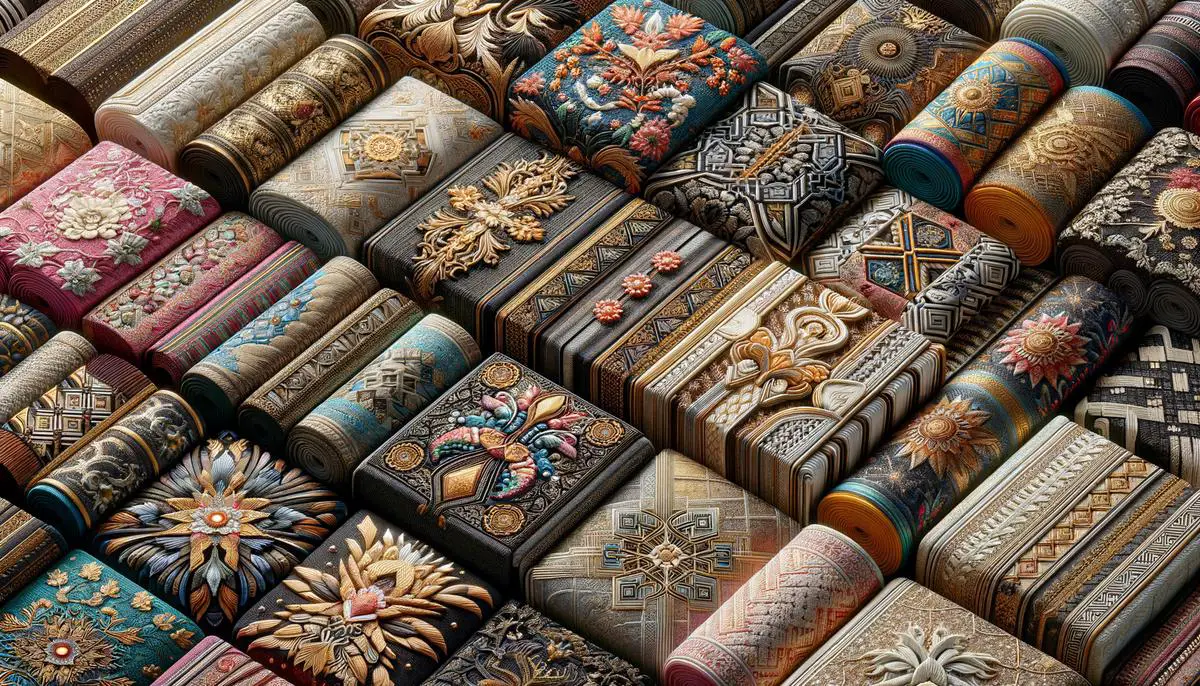
Manufacturing Process of Brocade Fabric
The following is the flow chart for the manufacturing process of brocade fabric.
Dyeing
↓
Designing
↓
Warping
↓
Weaving
↓
Jacquard Weaving
↓
Finishing
The description of every stage is given below:
The portrayal of each organize is given below:
- Dyeing: The required yarn that makes the brocade fabric gets colored some time recently the weaving process.
- Designing: Computer-aided plan (CAD) program or manual labor are utilized to deliver the brocade fabric’s design.
- Warping: The longitudinal twist strings are arranged and put on a loom To make the wanted plan.
- Weaving: The level weft strings are weaved into the twist strings utilizing a carry or other weaving processes to frame the craved plan.
- Jacquard Weaving: A Jacquard linger is commonly utilized to weave brocade cloth, empowering the creation of perplexing designs and motifs.
- Finishing: The brocade cloth is cleaned, colored, and sometimes improved with globules or weaving after it has been woven.
Brocade fabric speaks to an tricky abundance, from the twist and weft of its expand themes to the wrapping up touch that embellishes an lovely couch or a enormous ballgown. It announces its position in current plan with strength whereas whispering stories of collectible workmanship. The handle of making brocade, from its carefully chosen filaments running through the linger to its last creation as an extravagant work of craftsmanship, highlights the complex move between advancement and convention. This fabric is a truly advanced choice for anybody looking for to implant their makes or closets with a indicate of glory and history. Since it not as it were embellishes but too tells a tale.
Ultimately, the expand designs and profound surface of brocade fabric make it a luxurious and modern choice for clothing, insides plan, and ceremonial clothing. Its cost and upkeep needs are a few of its disadvantages but it too offers numerous benefits such as its life span and adaptability.

